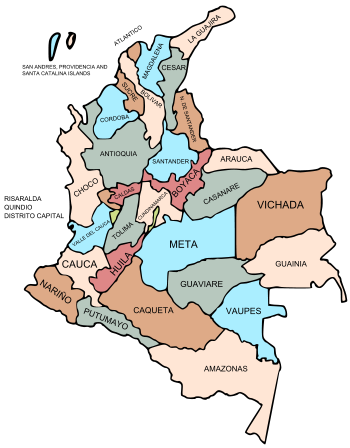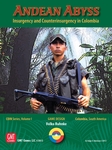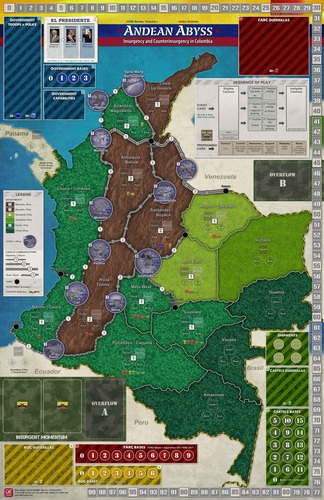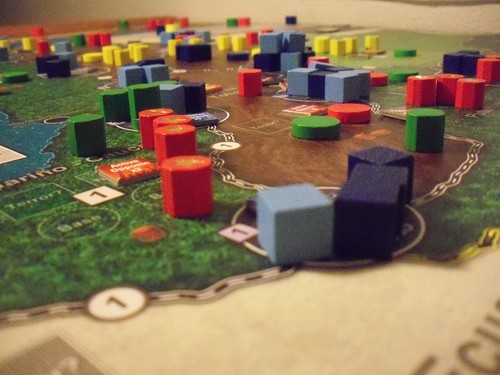Prova sul campo rappresenta “la voce” dei soci A.S.G.S. in merito a vecchie e nuove simulazioni che il mercato dei board-wargames offre. Una serie di pagine dove poter trovare piccole recensioni e/o resoconti di partite sui board-wargames che vengono giocati dal gruppo.
Siamo sempre alla ricerca anche di collaboratori; se volete inviare articoli su giochi che amate e conoscete, contattate l’Amministratore.
Un interessante sito con recensioni: http://www.armchairgeneral.com/category/boardgame-reviews
| Da Wikipedia:
http://it.wikipedia.org/wiki/Colombia, articolo sulla Colombia. La storia recente La divisione dei poteri tra liberali e conservatori continuò anche dopo la fine del Fronte Nazionale nel 1974, anche se fu consentita la partecipazione di altri partiti politici dopo la riforma costituzionale del 1968. Nel corso degli anni settanta si formano altre forze guerrigliere, tra le quali l’M19 e l’EPL. Nel 1982 arrivò alla presidenza del paese Belisario Betancourt Cuartas, che propose di dialogare con le principali forze guerrigliere: EPL, M19, ELN e FARC…………………………
|
|
Andean Abyss GMT Games Introduzione Andean Abyss coinvolge da 1 a 4 giocatori in una campagna per il controllo della Colombia: guerriglieri e polizia, terrorismo, guerra di droga, ecc. Ognuna delle 4 fazioni in lotta (Governo, FARC, AUC, Cartello) utilizza capacità e tattiche diverse per influenzare gli affari nella regione. Il sistema di gioco è “un derivato” dei carddriven, ma in questo caso le carte sono utilizzate in modo diverso e gli eventi, in particolare, sono assolutamente imprevedibili. AA enfatizza il gioco nei confronti della simulazione ma offre in ogni caso un buon strumento per ricreare il fenomeno delle insurezzione e controinsurrezione, tipica dei paesi di quell’area. L’autore, Volko Runke, già famoso per i suoi precedenti titoli di successo, quali Wilderness War e Labirynth, ha già in progetto altri titoli della serie che è stata denominata:COIN Series -COunterINsurgency series. Volko è stato contattato dal sottoscritto e, gentilissimo, si è reso disponibile ad una piccola intervista!! Vedi sotto. Dal sito della GMT: COIN Series Volume II Cuba Libre—Castro’s Insurgency 1957-1958 and Volume III A Distant Plain—Insurgency in Afghanistan are now on the P500 list. Future volumes will include Bush War—The Fall of Portuguese Angola, Long Hard Slog—The Iraqi Insurgency, and more. Contenuto della scatola La scatola, di dimensioni “alte”, cioè di spessore che permette di immagazzinare il materiale di gioco, è molto bella. Ormai la GMT, specie per gli utlimi titoli, produce contenitori di altissimo livello qualitativo. L’immagine in copertina è quella di un gurrigliero colombiano (probabilmente……….); il retro presenta le informazioni sul gioco e i suoi contenuti. Mappa La mappa, di dimensioni standard, è cartonata e coloratissima. Viene raffigurata le zona della Colombia e in piccola parte i paesi limitrofi, quali Venezzuela, Panama ed Equador. Suddivisa in zone o meglio i Dipartimenti, città e linee di comunicazione appare, a prima vista, un pò caotica ma risulta poi perfettamente giocabile. Lungo il perimetro troviamo vari “box” che permettono lo stoccaggio delle unità del gioco quali le basi, esercito e guerriglieri. Fondamentali la tabella su cui registrare i punteggi e le risorse e la tabella “Sequence of play”, cuore del gioco.
Pedine e counters Un unico set di markers è presente nel gioco; controlli governativi, controlli FARC, vari Eventi, il “terrore” e, importanti, lo status di supporto attivo/passivo e opposizione attiva/passiva. Le classiche pedine sono sostituite, in AA, dai “blocks”, suddivisi per colore in quelli governativi (blu/azzurri. basi, polizia ed esercito) e quelli delle tre fazioni di guerriglieri (rossi, FARC; gialli, AUC; verdi, Cartello). I blocks sono molto belli, stile Labirynth. Le unità militari della guerriglia presentano su uno dei lati una stellina che significa, quando visibile, unità avvistata.
Alcune pedine e markers Carte Le carte sono belle; presentano immagini, testi di Eventi e i simboli delle varie fazioni in gioco. Andean Abyss NON è un carddriven, ma un boardgame “assistito da carte”. In pratica i giocatori non avranno più “la mano di carte” che possono usare come punti comando e/o eventi e/o altro, ma carte che stabiliscono l’ordine di gioco e la possibilità di svolgere alcuni eventi. In partcilare in AA le carte hanno i 4 simboli delle fazioni coinvolte raffigurati ina maniera random per ogni carta; la posizione di tali simboli stabilisce quale fazione avrà l’iniziativa di “mossa/evento”. Se una fazione passa guadagna risorse e potrà giocare successivamente. Una enensima “evoluzione” che, grazie all’autore, apre nuove possibilità nel settore delle simulazioni! Tabelle di gioco Ben “7 doppie tabelle” sono fra la dotazione del gioco! Ogni giocatore ha infatti lo schema generale delle azioni possibili che lo riguardano e anche quelle avversarie. In cartoncino pesante, a colori, chiarissime, sono lo “stato dell’arte”. Ottime, poi, le tabelle dedicate alla versione in solitario del gioco. Libretto del Regolamento “Solo” 14 le pagine del regolamento di cui 3 quelle dedicate al gioco in solitario; chiaro, a colori, di complessità media. Libretto degli Scenari Al contrario ben 43 le pagine dedicate al playbook! In questo caso siamo allo “stato dell’arte”: tutto a colori, decine di esempi di gioco, guida alle varie operazioni possibili, esempio anche per il gioco solitario, note del disegnatore, testo delle carte e relativo “background e infine le fonti. Dadi; 3, a 6 facce dei colori specifici per le fazioni FARC, AUC, Cartello.
Una fase della partita Valutazione generale Pro: Grafica notevole stile eurogames, ottimi materiali, difficoltà media, meccanismo di gioco innovativo, ambientazione particolare ma interessante. Consiglio di leggere il libretto con le note e gli esempi di gioco; è molto istruttivo e permette di capire bene alcuni meccanismi. Contro: periodo storico poco conosciuto in Europa, unità militari generiche. Il sistema di gioco, se non si conoscono gli antefatti, non riesce ad esprimere il periodo storico ricreato. Consiglio, in questo caso, di giocare almeno 4/5 partite, anche in solitario, e concentrasi sugli Eventi descritti dalle carte; il periodo storico ne “uscirà” e la simulazione diventerà “didattica”. Una bella recensione: http://thegaminggang.com/2012/09/the-soul-of-colombia-at-stake-andean-abyss-reviewed/ Anche una “video recensione“: http://www.youtube.com/watch?v=uck7wc4sE3g&feature=player_detailpage
|
|
€ 72 – GMT Games |
|
L’autore del gioco, Volko Runke, è già noto fra gli appassionati per i primi due titoli, sempre pubblicati dalla GMT: Wilderness War e Labirynth; entrambi sono stati oggetto di precedenti recensioni, vedi: |
|
https://exasgs.sanmarinogame.com/copia/articles.php?article_id=130 – Labirynth https://exasgs.sanmarinogame.com/copia/articles.php?article_id=66 – Il fenomeno dei CardDriven |
|
Intervista di Giancarlo Ceccoli a Volko Runke, autore di Wildernes War, Labirynth, Andean Abyss. GC: Volko Hello, and thank you for accepting my request for a small interview to be published on the website of our association. First of all, what do you do, besides being a great author of boardwargames? VR: thank you so much for the compliment and for a chance to address your readers! I mainly also raise two boys (who playtest my designs!) and to make living I am a foreign affairs analyst for the US Government, at the moment working as an instructor of other analysts. GC: I’m a fan of CardDriven; the first title, We the people of Mark Herman has opened the door to a great series of games. There have been various changes of rules, systems, etc.. in cardriven. Your 3 titles seems to me that cover some of these innovations. In particular: Wilderness War is a classic cardriven, derived from systems like We the people or Succesors; Labirynth uses a similar system to that of Twilight struggle; Andean Abyss is a further evolution of your Labirynth but perhaps closer to a style “Eurogames”. This my classification is correct? VR: Yes, that genealogy is correct. Wilderness War is a direct descendant of Hannibal Rome versus Carthage by Mark Simonitch, which was the second CDG, following We The People. Labyrinth began with Twilight Struggle as a basis, but of course went in a different direction, keeping mainly the mechanic of triggering enemy events. When I asked myself, what would TS look like if it were set in the modern era, I found that I needed several new ideas. Andean Abyss was my next commercial design after Labyrinth, and has a few borrowed ideas — Guerrillas in AA look and work a little like Cells in Labyrinth, both games have asymmetry and solitaire systems. But Andean Abyss is really of a different type than any of the CDGs that you mention, as well shall discus… GC: Speaking of Labirynth, it is clear that this game has created the “phenomenon asymmetry”; if the old board-wargames had to be balanced as much as possible with different armies, but as equal as possible in features, now the differences between the various forces are a feature and quality of games like this. Volko, you would have thought such a success asymmetries? VR: I have always thought such situations the most interesting and therefore the basis of success in making an interesting game. Long ago I played the original Cosmic Encounter and loved the interplay of different player powers. Powers give personality, and everyone likes personality in characters in a story, so asymmetric powers help make a great story happen in a game. Much more recently I played Joe Miranda’s Battle for Baghdad, with 6 different victory conditions, very interesting to play and track what al players are up to. So it was clear to me that design with both asymmetric capabilities and asymmetric objectives would be very interesting design indeed. GC: In fact, the principle of the activations of the players involved through the use of “operations” is what characterizes Labirynth and AA, but also in embryo WW had this feature (Infiltrations, Raids). Right? VR: Yes, in embryo. WW used a similar multi-operations menu as HRvC or Paths of Glory, in WW’s case, move, build forts, and so on. And Auxiliaries such as Indian units behaved differently than Regular (European-style) troops. The situation was asymmetric because the French had the most Auxiliaries and the British had the most Regulars. But both had some of each type, could use both styles of fighting, and scored victory points the same way. So WW had important features in symmetry as well. GC: Andean Abyss sees you create a multiplayer game. The asymmetric characteristics of the armies involved are significant and the interactions between the four players enormous. Maybe it was useful to have pieces of the various military factions that highlight the very different; precisely asymmetries. The blocks are beautiful, for Labirynth perfect, but I believe that for a series of classical pieces AA would be better. VR: Well, you will have to judge for yourself. For me, I used only the complexity needed to show the level of decisionmaking and negotiation that I was interested in focusing on. Andean Abyss is not about the 53rd FARC Front being a bit stronger than the 67th Front and how that difference affects your military operations. It is about mobilizing a guerrilla army on a national scale and who to fight when and where, and so on. The wooden pieces have exactly as much meaning and detail needed to show what is happening in the insurgency at the national level. WW, for example, is operational-level simulation; AA is strategic; Labyrinth grand-Strategic. AA needs more pieces than Labyrinth, but wooden bits still do the job perfectly for me. GC: Andean Abyss is not a Cardriven, but a game assisted by cards. As you say in Thank you Giancarlo again for this opportunity, and I hope your readers will enjoy the games! Volko |
 |






